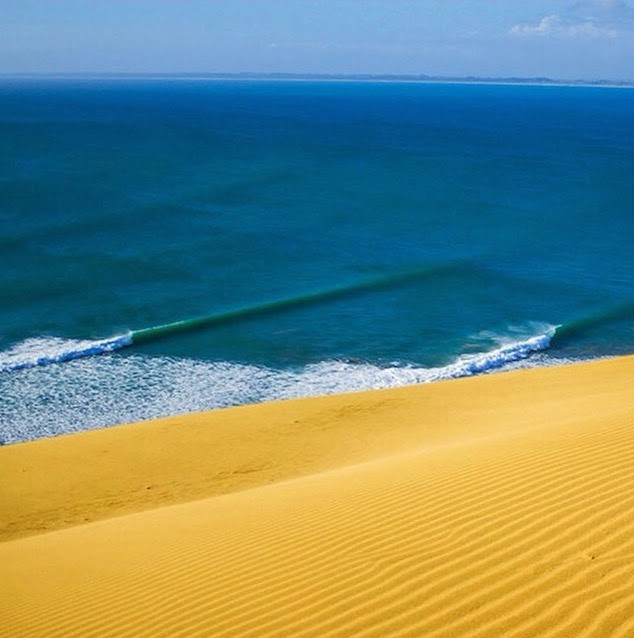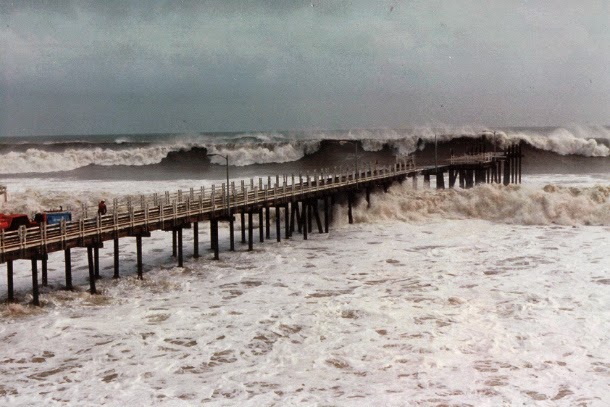Y'all ready for this?!
SURF:
Fun surf this week. Nothing big but mostly fun combo surf all week. We had a good storm a few days ago in the southern hemisphere turn into a monster (more on that below), but at least the first part of the storm sent us fun shoulder high waves this afternoon and tomorrow will be more of the same, along with waist high+ NW windswell.
As the storm grew last week into 50' seas, it unfortunately was due S of us (just on the edge of our swell window), but we'll still get overhead sets by Sunday afternoon, with the OC getting the rogue 10' set. All in all some fun surf this weekend with the best waves Sunday afternoon. Time to ride a real board. Water temps have rebounded nicely and are 64 in Dana Point and 67 in La Jolla.
Tides this weekend are 3' at sunrise, up to 4' mid-morning, down to 1' late afternoon, and up quickly to 5' at sunset.
FORECAST:
The solid S swell will keep turning and burning into Monday as the swell peaks with 8'+ sets in the far north part of SD county and best OC spots hitting 12'. The swell starts to wind down on Tuesday but it still will be solid around here.
Next up on the charts is a waist-chest high NW ground/windswell for SD on Wednesday and on it's heels is a fun SW swell starting late Friday.
Look for shoulder high sets in north county SD and head high waves in the OC by next Saturday.
And then... charts show more storms off Antarctica that will give us fun SW swell the middle of May. Make sure to keep up to date on these developing storms by visiting Twitter/North County Surf.
WEATHER:
Still pretty mild around here. Sure we had some high 70's at the beaches the past few days but at least it's not a full blown 90 degree Santa Ana situation. High pressure starts to break down tomorrow afternoon as a weak low pressure system heads into our area. The result will be more low clouds/fog in the nights/mornings. Temps will be back to 70 at the beaches most of next week. And no rain in sight until maybe monsoon season starts in July.
BEST BET:
Monday. Or if you can't wait that long, Sunday afternoon.
NEWS OF THE WEEK:
Blame it on global warming or just a natural evolution of the earth, but a quarter of the world’s coral reefs have died off in recent decades. Have you always wanted to take a trip to Tavarua? Do it quick. But all may not be lost according to the NY Times (yes- that New York- the one that gave us the epic Slater/Owen battle at the 2011 Quik Pro. Oh- and Balaram Stack. Oh- and can’t forget The Ramones). The NY Times reported recently that man made efforts may be able to re-build the reefs. And I’m not talking about those crappy artificial reefs that produce crappy waves. I’m talking real coral reefs that can help reverse the current destruction due to man-made or natural occurrences. Read on:
SUMMERLAND KEY, Fla. — David Vaughan plunges his right arm down to his elbow into one of nine elevated tanks where thousands of tiny colonies of coral are growing at an astonishing rate in shaded seclusion next to the Mote Tropical Research Laboratory. “Now this is the exciting part. You ready for this?” he asks, straining to be heard over the relentless hiss of filtered saltwater squirting from a maze of pipes and plastic tubing into the shallow fiberglass tank, the size of a dining-room table. Dr. Vaughan, a marine biologist who is executive director of the laboratory, retrieves a flat rock from the bottom. A chocolate-brown colony of brain coral, nearly eight inches wide, has grown on the stony surface, its distinctive fleshy, serpentine folds nearly covering the rock. A year ago the colony began as inch-and-a-half-wide coral fragments cut with a band saw from the same parent colony. As if doused with a growth elixir, these coral “seeds” began to grow 25 times as fast as they would in the wild. And when arranged a few inches apart on the rock, the mini-colonies quickly advanced across the surface and fused to become a single grapefruit-sized organism that continues to grow. Other species grown from tiny coral seeds in the Mote lab have developed even faster — up to 50 times their normal rate. Dr. Vaughan and a staff biologist, Christopher Page, say this quick-grow technique, called microfragmenting, may make it possible to mass-produce reef-building corals for transplanting onto dead or dying reefs that took centuries to develop — perhaps slowing or even reversing the alarming loss of corals in the Florida Keys and elsewhere. “This is real,” Dr. Vaughan said. “This potentially can be a fix.” Other scientists are excited, too. While there are other efforts around the world to grow new coral, “this is easily the most promising restoration project that I am aware of,” said Billy Causey, a coral expert who oversees all federal marine sanctuaries in the Southeastern United States, the Gulf of Mexico and the Caribbean for the National Oceanic and Atmospheric Administration. “Dave and Chris are buying us time,” he added. “This will keep corals out there” until “we can come to understand what is happening to coral on the larger scale.” Still, even Dr. Vaughan’s cheery optimism has its limits. A quarter of the earth’s corals have disappeared in recent decades, and the Mote scientists say no one can predict what will happen if the oceans continue to warm, pollution and acidification increase, overfishing further decimates species beneficial to coral, and land runoff continues to reduce the amount of life-giving sunlight that reaches the bottom. “We do not know if this is a fix-all,” Mr. Page said. “At worst, we’re buying a little time. At best, we could restore the ecosystem.”
To find out more, check out the full article here.
PIC OF THE WEEK:
California has so many diverse places to visit it can make your head spin. San Diego, Hollywood, Napa, Disneyland, Lake Tahoe, and now this- the world's longest artificial wave at La Quinta- just outside of Palm Springs. And if you believe that, I have a bridge in San Francisco I'd like to sell you.
Keep Surfing,
Michael W. Glenn
Life Of The Party
I Was Born Ready
Can Get Any Wave I Want At Lowers

























































